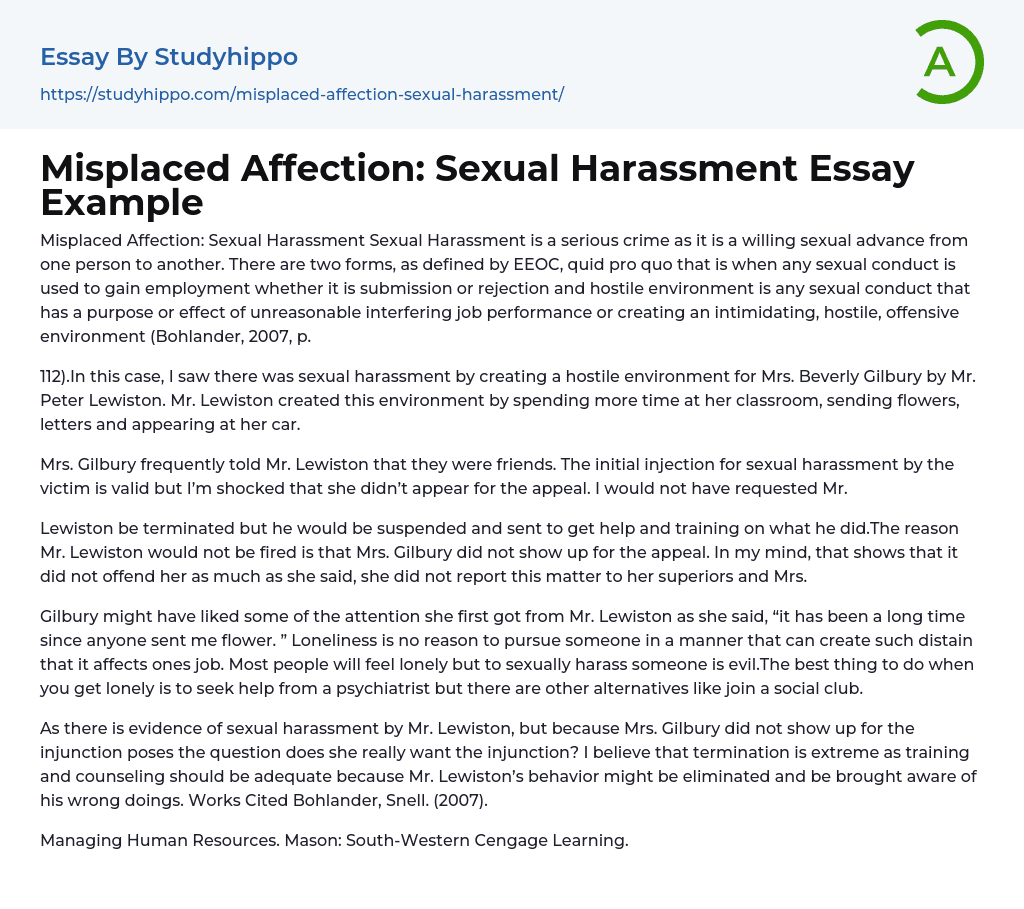The EEOC defines Sexual Harassment as unwanted sexual advances from one person to another, which is classified into two categories: quid pro quo and hostile environment. Quid pro quo involves using sexual behavior as leverage for employment, while hostile environment refers to any sexual conduct that hinders job performance or creates an intimidating or offensive workplace (Bohlander, 2007, p.).
According to my findings, Mr. Peter Lewiston caused sexual harassment to Mrs. Beverly Gilbury by establishing an environment that made her feel uncomfortable. This was accomplished by Mr. Lewiston frequenting her classroom, sending letters and flowers, and showing up at her car.
Although Mrs. Gilbury often claimed to be friends with Mr. Lewiston, the accusation of sexual harassment against him was found to be credible, even though she did not attend the appeal. The speaker po
...ints out that they would not have sought help from Mr. Lewiston in resolving this issue.
Although Mr. Lewiston will not be fired, he will face suspension and training to address his behavior. This decision was made because Mrs. Gilbury was not present during the appeal, indicating that she may not have been as offended as she had initially stated. Additionally, she neglected to inform her superiors of what had happened.
Gilbury was grateful for Mr. Lewiston's initial attention and mentioned that it had been a while since she received flowers. Nonetheless, pursuing someone out of loneliness in a manner that is considered sexual harassment is unacceptable and can have adverse effects on one's career. Although feeling lonely is a typical human experience, it is crucial to seek assistance from mental health experts like psychiatrists or consider joining social clubs to address
feelings of isolation.
The existence of sexual harassment committed by Mr. Lewiston is apparent, however, the fact that Mrs. Gilbury failed to appear for the injunction raises doubts about her true desire for the injunction. In my opinion, termination is too severe a punishment. Instead, training and counseling would suffice in order to eliminate Mr. Lewiston's inappropriate behavior and raise awareness about his misconduct. Bohlander, Snell. (2007) is a reference source for this statement.
The book "Managing Human Resources" is published by South-Western Cengage Learning.
- Adult essays
- Aggression essays
- Altruism essays
- Archetype essays
- Behavior essays
- Certainty essays
- Conformity essays
- Deception essays
- Human Behavior essays
- Human Sexuality essays
- Maturity essays
- Morality essays
- Obedience essays
- Procrastination essays
- Reinforcement essays
- Role Model essays
- Animal Cruelty essays
- Charles Manson essays
- Crime Prevention essays
- Crime scene essays
- Criminal Justice essays
- Criminology essays
- Cyber Crime essays
- Damages essays
- Detention essays
- Distracted Driving essays
- Drug Trafficking essays
- Drunk Driving essays
- Forensic Science essays
- Gang essays
- Hate Crime essays
- Homicide essays
- Identity Theft essays
- Juvenile Crime essays
- Juvenile Delinquency essays
- Juvenile Justice System essays
- Law Enforcement essays
- Murder essays
- Organized Crime essays
- Penology essays
- Piracy essays
- Prison essays
- Property Crime essays
- Prostitution essays
- Punishment essays
- Punishments essays
- Rape essays
- Robbery essays
- Serial Killer essays
- Sexual Assault essays




